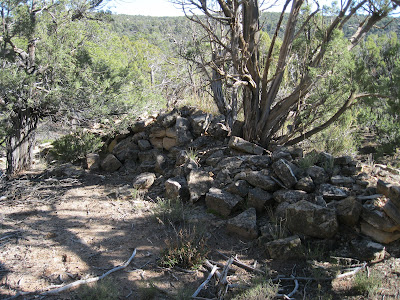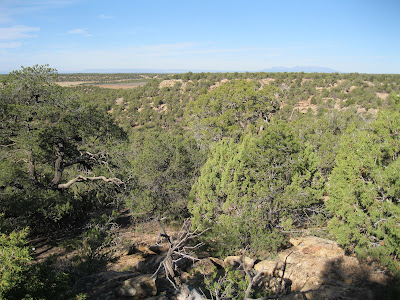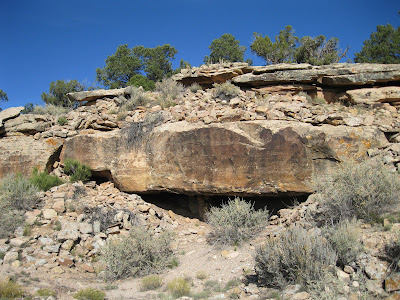When hiking in the Canyons of the Ancients, it is helpful to scan the cliffs and hilltops with binoculars as these hidden sites will be sometimes visible from the distance. I started this hike 2.2 miles south of the carbon dioxide gas plant that is located at the junction of County Roads U and 14, west of the community of Yellow Jacket northwest of Cortez, CO.
At this spot there are good views south over the wide and deep Yellowjacket Canyon. Looking the other way, to the northwest, there is a large boulder with rubble on top about 1 mile away. I had noticed this boulder from several angles on other hikes in this area.
There are two small drainages to cross to get to this site. After arriving at a point where there is a good overall view, I saw that there are actually three boulders with rubble ruins on top. The large south facing site overlooks the junction of the two small drainages and there are some rocky cliff outcrops at the junction.
Walking up canyon a short distance, there is an easy crossing and I visited the site from east to west. The first boulder site is the smallest and isn’t the one that is visible from a distance. There are several other boulders without rubble piles that can be climbed for different views.
Between the first and second boulder ruins sites, there are some wall sections to find against the cliff walls. There is an unusual small structure with good quality bricks a short distance in front of the cliffs. One could guess this is some sort of storage but it is hard to tell.
The second boulder has a more substantial rubble pile on top and there is an adjacent boulder to climb on to get a good view. The Canyons of the Ancients area has many more of these boulder based structures that seem to be present at Mesa Verde and the Cedar Mesa area in Utah. I’ve wondered if the former presence of wolves in this area has anything to do with this. I’ve never seen any mention of wolves in the interpretive material that is widely available for this area.
Behind the third boulder there is a petroglyph of concentric circles. There are many vertical rock surfaces at this site, but this is the only rock art that I saw.
The third boulder has the most rubble of the three. This is the one that is visible from the distance.
Off to the side of the third boulder there is a retaining wall that is filled in with soil and provides a level and smooth area. This wall is positioned like a check dam and would have caught runoff water from the cliffs above. Most of the pottery shards that I saw in this area are in the drainage below this retaining wall.
I found a place to climb to the top of the cliffs where there is a good view of the rubble on top of the boulder and the overall site. Once on top, I decided to loop back toward my starting point, walking east along the cliffs. The road and the power lines along the main road are easily visible from the mesa top. I didn’t see any structures on top of the cliffs. It took me about 0:45 minutes to arrive at this site and I lingered here for 0:45 minutes.
The return hike taking the different route took 1:15 hours. On the way, up canyon from the three boulder based ruins, I found another boulder based site. I didn’t see any others structures associated with this site. My total hike took 2:45 hours for about 4 miles on a 52 F degree late November day.

















































